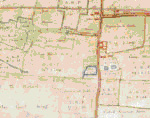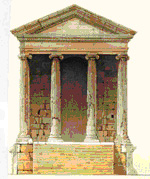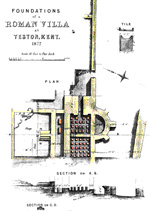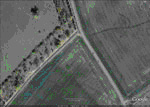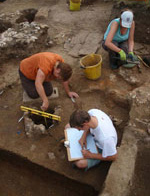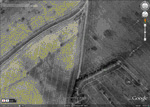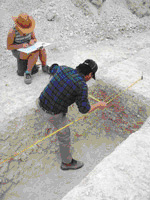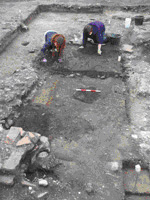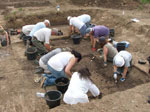 |
|||||||||||||||||||||||||||||||||||||||||||||

|
WELCOME TO THE FIRST EMAIL LETTER FROM KAFS A Christmas Buffet lunch for members at School farm Oast, Faversham- Sat 14th December, all members welcome- RSVP to info@kafs.co.uk We will be sending a Newsletter email each month to keep you up to date with news and views on what is planned at the Kent Archaeological Field School and what is happening on the larger stage of archaeology both in this country and abroad. Talking of which we are extremely lucky this year to be able to dig with the University of Texas at Oplontis just next door to Pompeii. Also this year we have been invited to participate in excavations at Ostia, the port of Rome, so book early to avoid disappointment. At home we are digging the last of three Bronze Age round barrows at Hollingbourne in Kent where last year in Barrow 2 we found a crouched burial and a complete bovine burial (below). Work will continue on two Roman villa estates, one at Abbey Farm in Faversham, the other at Teston located above the River Medway close to Maidstone. 
So, look at our web site at www.kafs.co.uk in 2014 for details of courses and ‘behind the scenes’ trips with KAFS which will include: CHRISTMAS ARCHAEOLOGY VOUCHERS You can buy on line Christmas vouchers for that last minute gift - for more details see Contents. Plus a pagan tale for Christmas - Beowulf in Kent has now been published as a paperback and is available as a signed copy from the author - Paul Wilkinson - at £2.50 - email info@kafs.co.uk  PROJECT UPDATES - SYNDALE Our next big report to write is the work we have done in Syndale Park from 2003-2011. In 2003 KAFS was invited by the trustees to investigate the park with a view to informing on the extent and quality of the archaeology surviving in the park. What we have uncovered in geophysical survey and limited excavation has shed new light on the nature and extent of monuments within the park, which in turn has led to a wider investigation of the land north and south of the Roman Watling Street (below) which itself runs east-west through the park. The Roman fort and Roman small town of Durolevum have been located and on the brow of the hill a large Late Iron Age settlement exposed by evaluation. The study area lies within a rich archaeological landscape. To the west the standing remains of Stone Chapel and to the east the remains of the Anglo-Saxon cemetery in Kings Field.  The Roman road running through Syndale Park, also showing is Roman buildings which are part of the small town of Durolevum. COURSES IN 2014 We have a full programme of courses which can be seen below. To become a member or to book see ‘Contents’.
ARCHAEOLOGICAL NEWS Archaeologists have discovered an extraordinary Roman sculpture in the form of an eagle firmly grasping a writhing serpent in its beak. The find was uncovered on a site in the City of London, ahead of development of a 16 storey 291 bed hotel by Scottish Widows Investment Partnership (SWIP) and its development partners Endurance Land. The team from MOLA (Museum of London Archaeology) were at first hesitant to announce the discovery and to proclaim its Roman origins, owing to its almost unbelievable condition.  Specialists have now confirmed that the sculpture dates to the 1st or 2nd century AD. Depictions of eagles and serpents are typically Roman but the closest comparison to this sculpture comes from Jordan. The symbolism is understood as the struggle of good, the eagle, against evil, the snake. This theme is common in funerary contexts and an important Roman cemetery is known to have been located on the site. Archaeologists believe that this statue once adorned a rich mausoleum, the foundations of which were also unearthed. The lack of weathering on the statue corroborates this theory, as does the absence of detail on the back of the sculpture; suggesting it once sat it an alcove. Described by experts as ‘amongst the very best statues surviving from Roman Britain’, the skill of the craftsman is apparent; with the forked tongue of the snake and the individual feathers of the eagle still clearly discernible today. Some 65cm tall and 55cm wide, the sculpture is made from oolitic limestone from the Cotswolds. A well-known and celebrated school of Romano-British sculptors worked in the area but to date examples of their exquisite work has been scant and fragmentary. Michael Marshall, MOLA Finds Specialist, said: “The eagle is a classically Roman symbol and this new find provides a fascinating new insight into the inhabitants of Roman London and demonstrates their familiarity with the iconography of the wider classical world. Funerary sculpture from the city is very rare and this example, perhaps from inside a mausoleum, is a particularly fine example which will help us to understand how the cemeteries and tombs that lined the roads out of the city were furnished and the beliefs of those buried there." Reverend Professor Martin Henig, said: “The sculpture is of exceptional quality, the finest sculpture by a Romano-British artist ever found in London and amongst the very best statues surviving from Roman Britain. Its condition is extraordinary; the carving as crisp as on the day it was carved. All it has lost is the surface paint, probably washed away when it was deposited in a ditch.” The sculpture will go on display for 6 months at the Museum of London from the 30th of October 2013 so that members of the public can see this rare and remarkable piece in all its glory. Archaeological news/ Staffordshire Hoard KAFS VisitThe first pieces of the Staffordshire hoard were found in early July 2009 by Mr Terry Herbert while he was metal detecting in a field in southern Staffordshire. Mr Herbert reported the find to the Portable Antiquity Scheme's Finds Liaison Officer for Staffordshire and the West Midlands, based here at Birmingham Museums & Art Gallery. Because the find was so important, English Heritage and Staffordshire County Council funded an archaeological excavation which was carried out between 24 July and 21 August by Birmingham Archaeology. Following the excavation Mr Herbert found a few more pieces, but a final search of the site 14-15 September by a specialist police remote sensing team found nothing else, so it is likely that the entire hoard has been recovered.  What the hoard contains At least 1,500 artefacts and fragments were discovered. Most of the complete objects are made of gold - the hoard contains about 5 kilograms (11lbs) of gold - but there are also items of silver and copper alloy. The hoard is unusual because it largely seems to be made up of fittings that have been stripped from the hilts of swords and daggers (mostly pommel caps and hilt plates). No trace was found of any sword or dagger blades. In addition to the fittings, the hoard also contains parts of a helmet, plus at least two Christian crosses. Many of the gold items are decorated with pieces of garnet, a deep red precious stone. Others are covered in fine filigree work, or carry patterns made up of animals with interlaced bodies. What has happened since?The hoard was declared to be Treasure at a coroner's inquest held at Cannock on 24 September. Under the 1996 Treasure Act any gold or silver objects found that are more than 300 years old are Treasure, along with any objects found with them. As Treasure, the hoard belongs to the Crown, but in practice interested museums can acquire it by paying the finder and landowner its commercial value. This was assessed by the Treasure Valuation Committee, an independent body of experts on November 25th 2009. The Treasure Valuation Committee recommended the value of £3.285 million to the Secretary of State and this has now been agreed withBirmingham and Stoke City Councils as well as the finder and landowner of the Hoard. Hoard Saved for the NationOn 23 March 2010 The Art Fund announced that the Staffordshire Hoard has been saved for the nation. The news came after the National Heritage Memorial Fund (NHMF), the government's fund of last resort for heritage items at risk, pledged £1,285,000, bringing the campaign to the £3.3m target, just over three weeks ahead of schedule. Thanks to the support of the public, trusts and foundations, and the generous £1,285,000 NHMF grant, the find has now been safely secured for Birmingham Museums & Art Gallery and the Stoke Museums. Single donation from Court jewellers secures Staffordshire Hoard for nationLess than a week after the fundraising campaign was launched, the newly-found artefacts from the Staffordshire Hoard have been saved for the nation thanks to the generosity of the jewellers Wartski who made the Duchess of Cambridge’s wedding ring. Recently the Court Jewellers Wartski donated the full amount needed - £57,395 – in order to purchase the 81 additional pieces of Anglo-Saxon treasure that were found last November in the same Staffordshire field as the initial 3,500-piece collection. Wartski is a family jewellery business in London. To join the ‘behind the scenes’ visit with KAFS email your interest to info@kafs.co.uk or log on to our web site to reserve a place in 2014.  CHRISTMAS GIFT VOUCHERS You can buy Gift Vouchers from KAFS for £25 a day in one, two or five days. Pay online at www.kafs.co.uk and an e-voucher will be sent to you-Merry Christmas!  OPLONTIS PROJECT If you wish to book for week 1 or 2 on the following Field Trip: Oplontis Roman Villa B, Pompeii, Naples, in association with the University of Texas. Week 1. 2nd-6th June 2014Week 2. 9th-13th June to 2014 Fees: £175 a week. Please note food, accommodation, insurance, and travel are not included. Flights to Naples are probably cheapest with EasyJet. To get to Pompeii take a bus from the Naples airport to the railway station and then the local train to Pompeii. Hotels are about 50eu for a room per night. We are staying at are the Motel Villa dei Misteri and the Hotel degli Amici. info@villademisteri.it info@hoteldegliamici.it For camping (where I shall be) the site Camping Zeus is next to the hotel: info@campingzeus.it and is about 7eu a night. Transport to Oplontis from Pompeii can be provided. Please note it can be hot so bring sun cream and insect repellent! Any queries email me at info@kafs.co.uk or in Naples call my mobile on 07885 700 112. 
You will have the opportunity to excavate on a World Heritage Site overwhelmed by the volcanic eruption of AD79. The site of Villa B is about 300 metres to the east of Villa A. For further details see oplontisproject.org FIELD TRIP TO ZEUGMA, MAY 2014 The ancient city of Zeugma was originally founded as a Greek settlement by Seleucus I Nicator, one of the generals of Alexander, in 300 BC. King Seleucus almost certainly named the city Seleucia after himself; whether this city is, or can be, the city known as Seleucia on the Euphrates or Seleucia at the Zeugma is disputed. The population in the city at its peak was approximately 80,000. 
In 64 BC Zeugma was conquered and ruled by the Roman Empire and with this shift the name of the city was changed into Zeugma, meaning "bridge-passage" or "bridge of boats". During Roman rule, the city became one of the attractions in the region, due to its commercial potential originating from its geo-strategic location because the city was on the SilkRoad connecting Antioch to China with a quay or pontoon bridge across the river Euphrates which was the border with the Persian Empire until the late 2nd century. In 256, Zeugma experienced an invasion and it was fully destroyed by the Sassanid king, Shapur I. The invasion was so dramatic that Zeugma was not able to recover for a long time. To make the situation even worse, a violent earthquake buried the city beneath rubble. Indeed, the city never regained the prosperity once achieved during the Roman rule. Zeugma and environs remained part of the Roman Empire. During the 5th and 6th centuries the city was ruled by the Early Byzantium or Eastern Roman Empire. As a result of the ongoing Arab raids the city was abandoned once again. Later on, in the 10th and 12th centuries a small Abbasid residence settled in Zeugma. Finally a village called Belkis was founded in the 17th century. The ancient city of Zeugma was originally founded as a Greek settlement by Seleucus I Nicator, one of the generals of Alexander, in 300 BC. King Seleucus almost certainly named the city Seleucia after himself; whether this city is, or can be, the city known as Seleucia on the Euphrates or Seleucia at the Zeugma is disputed. The population in the city at its peak was approximately 80,000. In 64 BC Zeugma was conquered and ruled by the Roman Empire and with this shift the name of the city was changed into Zeugma, meaning "bridge-passage" or "bridge of boats". During Roman rule, the city became one of the attractions in the region, due to its commercial potential originating from its geo-strategic location because the city was on the Silk connecting Antioch to China with a quay or pontoon bridge across the river Euphrates which was the border with the Persian Empire until the late 2nd century. In 256, Zeugma experienced an invasion and it was fully destroyed by the Sassanid king, Shapur I. The invasion was so dramatic that Zeugma was not able to recover for a long time. To make the situation even worse, a violent earthquake buried the city beneath rubble. Indeed, the city never regained the prosperity once achieved during the Roman rule. Zeugma and environs remained part of the Roman Empire. During the 5th and 6th centuries the city was ruled by the Early Byzantium or Eastern Roman Empire. As a result of the ongoing Arab raids the city was abandoned once again. Later on, in the 10th and 12th centuries a small Abbasid residence settled in Zeugma. Finally a village called Belkis was founded in the 17th century. During the Roman Era, the Legio IV Scythica was camped in Zeugma. For about two centuries the city was home to high-ranking officials and officers of the Roman Empire, who transferred their cultural understanding and sophisticated life style into the region. Thus the military formation acquired a Roman character and gave rise to an artistic trend of necropolis sculpture. In this respect, samples of beautiful art appeared in the form of steles, rock reliefs, statues and altars. This unique trend in sculpture and art made the newly emerging Zeugma art well recognized in whole region. Zeugma became considerably rich, owing to the liveliness created by Legion formation. At that time, there was a wooden bridge connecting Zeugma to the city of Apamea on the other side of Euphrates, and current excavations revealed that there was a big customs and a considerable amount of border trade in the city. The proof for this assumption came from the findings in the excavations carried out in “Iskele üstü”. In this site, 65,000 seal imprints (in clay, known as “Bulla”), were found in a place which is believed to serve as the archives for the customs of ancient Zeugma. The seal imprints used in sealing papyrus, parchment, moneybags, and customs bales are good indication of volume of the trade and the density of transportation and communication network once established in the region. In 1987 the Gaziantep Museum excavated two tomb chambers which had been broken into by antiquity smugglers in the necropolis southwest of Zeugma, revealing frescoson the walls and statues on the terraces in front of the chambers. These statues are now in the Gaziantep Museum of Archaeology. In 1992 the watchman at the site, Nusret Özdemir, reported renewed illegal activity here, and a trench dug by antiquity hunters was discovered in the centre of the city. Excavations commenced on the same spot by a team from Gaziantep Museum led by director Rifat Ergeç uncovered a Roman villa and magnificent mosaic pavements. The 1st century AD villa consisted of galleries around an atrium with eight columns and rooms behind the galleries. The mosaic which adorned the villa's gallery depicted the marriage of Dionysus, god of wine and grapes, to Ariadne. Sadly, six of the ten figures portrayed in this mosaic were stolen on 15 June 1998. In further excavations here, in which David Kennedy from Australia participated in 1993, part of the central panel of the mosaic pavement belonging to the terrace of another villa turned out to have been stolen long since - probably around 1965 - so the two figures are missing from the knees upwards. The missing mosaic fragment was later found to be in the Menil Collection at Rice University in the city of Houston. The two figures seated side by side in this mosaic are the two legendary lovers, Metiokhos and Parthenope. At the request of the Turkish Ministry of Culture, the stolen fragment was returned, and the complete mosaic can now be seen in Gaziantep Museum.  The "Gypsy Girl" mosaic fragment (Zeugma Mosaic Museum)
The "Gypsy Girl" mosaic fragment (Zeugma Mosaic Museum)
When mosaic fragments were discovered during construction of the Birecik Dam wall which commenced in 1996, Gaziantep Museum had the work halted while excavations were carried out that revealed a Roman bath and gymnasium, and 36 mosaic panels which were added to the museum collection. In 1997, on the clay quarry area in front of the dam wall a large Bronze Age cemetery was discovered and excavated. Nearly eight thousand pottery vessels were found in 320 graves going back to the early Bronze Age. The museum staff worked unceasingly through the winter of 1998-1999, uncovering such important and beautiful finds as the Akratos and Gypsy Girl Mosaic and 65,000 bulla (seal imprints in clay) in an archive room at İskeleüstü, making Gaziantep Museum possessor of the largest bulla collection in the world. In 1999, in a building in the lower quarter of the city, mosaics depicting the head of Dionysus and Oceanus and Tethys with sea creatures were discovered. From 1996 onwards, with the threat of being submerged under the waters of the new dam, salvage excavations were carried out by C. Abadie Reynal of Nantes University in France together with archaeologists from Gaziantep and Şanlıurfa museums. In 1999 a mosaic pavement depicting the mythological Minos bull was discovered at Mezarliküstü, and at the end of the excavation season further mosaics were visible at the thresholds of other rooms. Not wishing to leave the mosaics at the mercy of the treasure hunters who are so active in the area, Gaziantep Museum’s acting director Fatma Bulgan decided to carry on with excavations through the winter months. Despite difficult weather conditions they went on to uncover a fountain with its own tank at a depth of three metres, and a marble figure of Apollo, as well as another mosaic pavement with nine figures depicting Achilles being taken by Odysseus to fight in the Trojan War. Also during salvage excavations under Mehmet Önal, an archaeologist from Gaziantep Museum, two more Roman villas were uncovered. These villas, which stood side by side, were burned and razed by the Sassanids in 252. The fact that they lay under three metres of rubble had protected them from treasure hunters, and their frescos, mosaics and other artifacts were almost completely intact. A bronze statue of Mars, which aroused increased media interest in Zeugma, was found amongst storage jars in the larder of one of the villas. Altogether seventeen mosaic pavements have been revealed in the villas, whose walls were decorated with colourful frescoes. Excavations of Zeugma have been divided into three areas, initial priority being given to salvage and documentation in Zone A, which sank under the dam waters in early July. Work then moved on to Zone B, which will be submerged in October 2000 when the dam water reaches its maximum level of 385 metres. Zone C, on the other hand, consists of the higher parts of the city which will not be affected by the new dam. Zeugma is one of the foremost of Turkey's archaeological and historic sites, and the attention focused upon it from all over the world will undoubtedly continue over the years ahead. Join KAFS on a field trip in May 2014 to Zeugma. It is a not a trip for the light-hearted but there are direct flights by Turkish Airlines direct to Gaziantep from Gatwick at about £250 return. Local accommodation and a local mini-bus plus local guide will be available and Dr Paul Wilkinson will see you safely around the site. Museums we will visit include: • Archaeological Museum This local archaeological museum hosts some stunning mosaics excavated from the nearby Roman site of Zeugma. The museum, which also has a small cafe inside, is wheelchair accessible.• The Castle's Museum. It is a great opportunity to learn from the Turkish point of view what happened in the WWI, especially what concerns to the dissolution of the Ottoman Empire and the further occupation. The view from the top of the castle is amazing. • Kitchen Museum. Museum about Turkish traditional cuisine, food, ingredients, tools and bon tòn. Very interesting. • Zeugma Mosaic Museum. Zeugma Mosaic Museum, in the town of Gaziantep, Turkey, is the biggest mosaic museum on the world, containing 1700m2 of mosaics. For more information on Zeugma see: http://www.zeugmaweb.com/zeugma/english/engindex.htm KAFS BOOKING FORM You can download the KAFS booking form for all of our forthcoming courses directly from our website, or by clicking here KAFS MEMBERSHIP FORM You can download the KAFS membership form directly from our website, or by clicking here |
||||||||||||||||||||||||||||||||||||||||||||
 |
|||||||||||||||||||||||||||||||||||||||||||||
